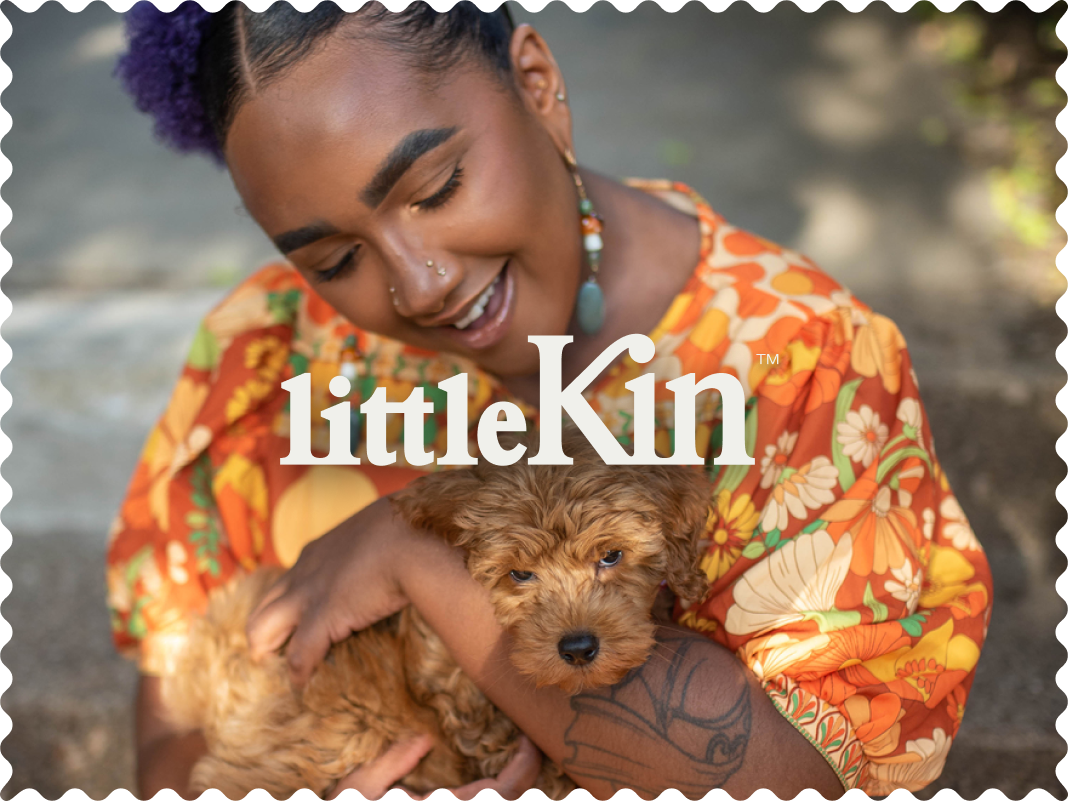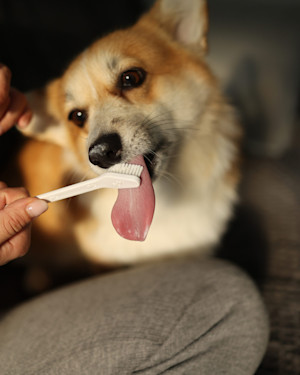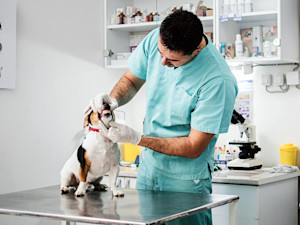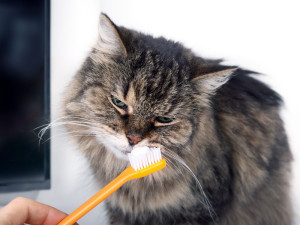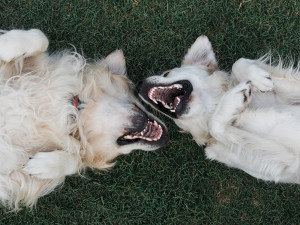Some Dog Breeds Are More Prone to Dental Problems – Is Yours One Of Them?
It’s not just the smallies who need regular brushing

Share Article
In this article:
What causes dental problems in dogs? Which dog breeds have more dental problems? Cat breeds prone to dental issues How to prevent dental problems in dogs Ways to keep your pet’s teeth clean When to see a vet
Dental health isn’t just an important part of your own health (reminder to book that dentist appointment you’ve been putting off!) but one that’s equally important for our pets. Often overlooked, dental disease is sadly a common issue with dogs and cats, and preventing the issue (or managing it, if it’s too late) should be one of your top priorities when it comes to caring for your beloved companion.
Dental disease is a painful and progressive condition. It causes gingivitis (inflamed gums), plaque and tartar which can lead to tooth root infections, decay, bone loss and teeth becoming loose and even falling out. Clinical signs are often subtle until the issue has progressed and is really painful. Therefore, it is important to know what early signs look like and when to react.
But how do we know which pets are more at risk? Are some breeds more likely to get dental issues than others? And, what can we do as pet parents and vets to keep their teeth sparkling white and pain free?
What causes dental problems in dogs?
There are multiple risk factors for dental disease. Genetics play a large role in the risk of dental disease. Periodontal disease is mostly diagnosed in smaller breeds of dogopens in new tab while medium to large breeds tend to have a lower prevalence. The exceptions are Greyhounds and Basset Hounds who have a high prevalence of dental issues.
Lifestyle plays its part alongside breed genetics. Dietary habits and types of treats given are a huge factor. High nutrition diets support gum and dental health, while dental specific diets and dry kibble can manually help to remove plaque. Diets lower in nutritional value and higher in sugars or diets made up of softer elements may increase the risk of dental disease.
There is also a correlation between age and dental issues, which makes sense as plaque and tartar need time to develop. As our pets get older, their immune system can become weakened or compromised by other concurrent conditions making it harder for them to fight off mild infections like their younger friends. This makes it all the more important that our golden oldies have their teeth (and the rest of their body!) regularly checked and then treated promptly.
Although often forgotten, the importance of routine dental care, frequent brushing and dental check-ups cannot be overstated. They are crucial for dogs of any breed or age. Lack of routine dental care is one of the main factors that increases risk of dental disease.
Which dog breeds have more dental problems?
All dogs should have 42 adult permanent teeth. 20 on the top jaw and 22 on the bottom. Small dog breeds or those that are brachycephalic (dogs who have disproportionately shortened snouts and jaws such as Pugs and Bulldogs) have to try to fit that same number of teeth along their smaller jaws. This can cause overcrowding or misalignment, where baby deciduous teeth don’t shed normally as the adult teeth fight for room to erupt. This can lead to overcrowding or retained deciduous teeth which can cause gaps and crevices where food can get stuck and bacteria can thrive. Dental disease can then progress with plaque, gingivitis and tartar.
Smaller breeds with increased risk include Chihuahuas, Yorkshire Terriers, Toy Poodles and Dachshunds as they all naturally have smaller skulls and jaws. Brachycephalic breeds such as Bulldogs, Pugs and Shih Tzus all have shorter snouts in proportion to the rest of their bodies and so are at greater risk of dental issues too.
However, it’s not just the smallies that are prone to dental issues: the most common health condition for Greyhounds is dental disease (39 percent affectedopens in new tab). This could be down to genetic predisposition, skull and jaw shape or the unique lifestyle and care (or lack thereof) of racing Greyhound athletes.
Cat breeds prone to dental issues
It is not just dogs that are at risk of dental disease, cats are often also affected. Cats are both predator and prey animals and so they are very good at masking chronic conditions and pain, which makes dental issues even harder to spot early. Breeds that are more at risk include the brachycephalic breeds (such as Persian catsopens in new tab and Exotic Shorthairs) who often present with dental disease for the same shortening of the jaw issue faced by brachycephalic dogs. Cats have fewer teeth than dogs, but they still need to try to fit all 30 adult permanent teeth into very small mouths.
Other breeds with a greater risk of dental disease include Siamese,opens in new tab Maine Coon and British Shorthair cats. Until recently, most research into dental disease in pets has been done on dogs and so continued research is needed to look into why these breeds in particular are more at risk.
Preventing dental problems
Prevention is always better than treatment, for the good of our pet’s welfare and for your bank balance. Regular tooth brushing is the main way to keep your pet’s mouth healthy and yes, that includes cats! Using a toothbrush and pet-safe toothpaste ideally 3–7 times a week is the best way to keep on top of plaque and biofilm build-up and gives you an opportunity to have a good look at your pet’s teeth and spot any issues early.
Alternative ways to keep your pet’s teeth clean
Other dental care can come in the form of dental chews, supplements and water additives all designed to help break down plaque or mechanically aid its removal. Ideally, go for products that have been approved by the Veterinary Oral Health Councilopens in new tab.
Hardened tartar, however, is a lot harder and cannot be removed through at-home methods safely. Dental treatments such as a scale and polish should not be attempted by non-veterinary professionals as sedation, pain relief and anaesthesia are needed along with possible dental X-rays to check bony interfaces and structures under the surface.
Professional instruments are needed to treat all seen and unseen aspects including the most important area under the gum line where the majority of problems reside. What you can visibly see is sometimes only the tip of the iceberg. Early diagnosis and treatment is key so remember to mention any concerns to your vet and not to miss your annual check ups.
When to see a vet
Symptoms you may be able to spot early include pets licking their lips more than usual, bad breath and changes in eating behaviour (for example, preferring to crunch kibble only on one side of their mouths), or only wanting softer wet food. These signs alone are enough of a reason to get them checked out by your vet. Red flag signs that need prompt care include:
Excessive drooling.
Loose teeth.
Loss of appetite or refusing food if out of character.
Bleeding gums.
Swollen areas to face or cheeks.
The bottom line: breeds most likely to have dental issues
While the breed of your dog or cat can increase the risk of dental issues, it’s important to remember that every breed can get dental disease. The main way you can prevent it is regular brushing and good oral hygiene. Routine checks performed both by you and your vet give a greater chance of catching symptoms early so treatment can start sooner, meaning issues are prevented from escalating to more serious conditions that need more invasive (and expensive!) treatments.
So, make sure your pet is up-to-date on their vet check-ups and aim to build an at-home oral hygiene routine. If you spot any of the symptoms listed above, make an appointment at your vet’s for prompt assessment and treatment.
References
Mestrinho, Lisa A., et al. “Oral and Dental Anomalies in Purebred, Brachycephalic Persian and Exotic Catsopens in new tab.” Journal of the American Veterinary Medical Association, vol. 253, no. 1, American Veterinary Medical Association (AVMA), July 2018, pp. 66–72, https://doi.org/10.2460/javma.253.1.66.
O’Neill, Dan G., et al. “Greyhounds under General Veterinary Care in the UK during 2016: Demography and Common Disordersopens in new tab.” Canine Genetics and Epidemiology, vol. 6, no. 1, BioMed Central, June 2019, https://doi.org/10.1186/s40575-019-0072-5.
O’Neill, Dan G., et al. “Periodontal Disease in Cats under Primary Veterinary Care in the UK: Frequency and Risk Factorsopens in new tab.” Journal of Feline Medicine and Surgery, vol. 25, no. 3, Mar. 2023, p. 1098612X2311581, https://doi.org/10.1177/1098612x231158154.
Wallis, C., and L. J. Holcombe. “A Review of the Frequency and Impact of Periodontal Disease in Dogsopens in new tab.” Journal of Small Animal Practice, vol. 61, no. 9, Sept. 2020, pp. 529–40, https://doi.org/10.1111/jsap.13218.
Veterinary Oral Health Council. (n.d.). Accepted Products | Veterinary Oral Health Councilopens in new tab. [online] Available at: https://vohc.org/accepted-products/.
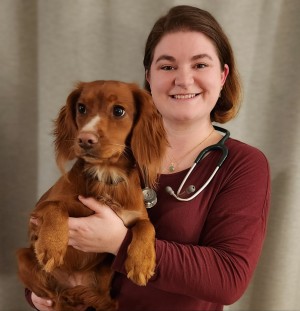
Dr Josephine Corrick, BVMSci, BSc, MRCVS
Dr Josephine Corrick, BVMSci, BSc, MRCVS is a veterinary surgeon based in the south of Scotland where she has been since graduating from the University of Surrey. She enjoys working in general practice treating small animals. Her particular interests include diagnostic imaging and the treatment of wildlife.
Having found a passion for veterinary medicine after doing a degree in Equine Sports Science she still enjoys including horses in her life by spending time with her highland ponies. Alongside her clinical work, she helps run a smallholding caring for rare breed sheep and exploring the Scottish countryside with her young Cocker Spaniel.
Related articles
![Cat grooming itself.]()
Dental Disease in Cats: Signs to Watch Out For & Prevention Tips
Much to their disappointment, taking care of your cat’s teeth is essential
![corgi dog licking toothbrush]()
10 Unexpected Reasons to Take Your Dog to The Dentist, Now
Your dog’s dental health affects their entire well-being
![a vet inspects the teeth of a jack russell dog]()
Preventing, Managing & Treating Gum Disease In Dogs
Everything you need to know about the most common – and preventable disease your dog can get
What Is the Best Way to Clean a Dog’s Teeth?
![Curious cat sniffing on toothpaste on toothbrush held by pet owner.]()
How to Brush Your Cat’s Teeth
It sounds like a daunting task, but here are some helpful steps to take
![a pair of English cream retriever dogs wiggle around on their backs with big grins on their faces]()
1 in 8 Dogs Has Dental Disease – Does Yours?
Here are four common dental problems your pup might face and how to treat them
![Outdoor shot of a woman holding her dog.]()
Doggie Dental Care: How to Choose the Best Toothbrush for a Puppy
Those pearly whites need all the attention they can get
